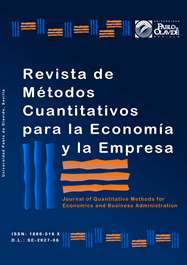Calculation of Operational Value at Risk of an Insurance Company through Bayesian Networks
DOI:
https://doi.org/10.46661/revmetodoscuanteconempresa.2737Keywords:
Riesgo operacional, Redes Bayesianas, Solvencia II, OpVar., Operational risk, Bayesian networksAbstract
It was in the 1990’s when the concept of Operational Risk was defined, since then the institutions, especially those in the financial sector, are worried about this type of risk since their exposure could have fatal consequences. In case of the insurance sector its study originates due to the new European regulatory framework of Solvency II. The purpose of this research is the development of a methodology based on Bayesian networks to identify and measure operational risk in order to determine the solvency capital requirement in the online policy quotation process of an insurance company that recently entered into this way of operating. For this, a Bayesian network model was designed with a priori and a posteriori distributions that allowed estimating the frequency and severity of the losses, with the posteriori distributions, an estimate of the expected loss for a period of one year was made using Monte Carlo simulation.
Downloads
References
Aczel−Sounderpandian (2009) “Business Statistics” p 692-788, Séptima Edición, Mac Graw Hill
Alexander, C. (2002) “Operational Risk Measurement: Advanced Approaches” ISMA Centre, University of Reading, UK
Basel Committee on Banking Supervision (BCBS, September 2001). “Working Paper on The Regulatory Treatment of Operational Risk”, Bank for International Settlements
Basel Committee on Banking Supervision (BCBS, 2006). “International Convergence of Capital.” Measurement and Capital Standards, Bank for International Settlements
Buhlmann, H., and A. Gisler. (2005) “A Course in Credibility Theory and its Applications, Springer, 2005
Carrillo, S; Suárez, A. (2006) “Medición efectiva del riesgo operacional”. Estabilidad Financiera, Vol. 11 pp. 61-89
CEIOPS, QIS5 (2010) Technical Specifications. http://www.eiopa.europa.eu
Cruz, M. G., (2002) “Modeling, Measuring and Hedging Operational Risk”, Hoboken: Wiley
Cummins, J.D., C.M. Lewis and R. Wei (2006) “The Market Value Impact of Operational Loss Events for US Banks and Insurers”, Journal of Banking and Finance, Vol. 30 p. 205-2634
Deloitte (2013) "Solvency II Requirements," available at www2.deloitte.com/uk/en/ pages/financial-services/solutions/solvency-ii.html.
Directiva 73/239/CEE
Directiva 2002/83/CEE
Directiva 92/96/CEE
Dutta, K., and J. Perry (2006) “A Tale of Tails: An Empirical Analysis of Loss Distribution Models for Estimating Operational Risk Capital”. Working paper, Federal Reserve Bank of Boston
European Commision. (2008) QIS4 Technical Specifications
Guidici P.(2004) “Integration of qualitative and quantitative operational risk data: a Bayesian approach”, in M.G. Cruz, ed., Operational Risk Modeling and Analysis.Theory and Practice, RISK Books, London, pp.131-138.
Hernández Barros, R., y Martínez Torre-Enciso, Ma. I, (2010) “La nueva regulación europea de seguros privados: Solvencia II”; Boletín de Estudios Económicos, Bilbao, No. 199 pp. 75-92
Hoffman, D. (1998) “New Trends in Operational Risk Measurement and Management”. Operational Risk and Financial Institutions, Arthur Andersen, Risk Books, London.
KPMG (2011) "Solvency II,", www.kpmg.com/US/en/IssuesAnd Insights/ArticlesPublications/Pages/solvency-II-closer-look.aspx y www.kpmg.com/US/en/IssuesAndInsights/ArticlesPublications/Documents/ solvency-II.pdf.
McNeil, A., R. Frey, and P. Embrechts (2005) “Quantitative Risk Management” Princeton, University Press
Mikosch, T. (2004 “Non-Life Insurance Mathematics: An Introductión with Stochastic Processes” Springer Verlag
Neil, M.N. Fenton and M. Tailor (2005) “Using Bayesian Networks to model expected and unexpected operational losses” Risk Analysis Journal Vol. 25, No. 4 pp. 963-972
Neil M., D. Marquez and Fenton N. (2004) “Bayesian Networks to model Expected and Unexpected Operational Losses”, Risk analysis, Vol. 25, No,. 4 pp. 675-689
Peters, G.W., A.D. Byrnes and P.V. Shevchenko (2011) “Impact of Insurance for Operational Risk: Is it Worthwhile to Insure or be Insured for Severe Losses” Insurance: Mathematics and Economics, Vol. 48 pp. 287-303
Reimer K and Neu P. (2003) “Functional correlation approach to operational risk in banking organizations”. Physica A: Statistical Mechanics and its Applications, 322 Pp 650-666
Shevchenko, P.V. (2010) “Calculation of Aggregate Loss Distributions”, Journal of Operational Risk, Vol. 5 pp. 3-40
Downloads
Published
How to Cite
Issue
Section
License
Copyright (c) 2019 Journal of Quantitative Methods for Economics and Business Administration

This work is licensed under a Creative Commons Attribution-ShareAlike 4.0 International License.
Submission of manuscripts implies that the work described has not been published before (except in the form of an abstract or as part of thesis), that it is not under consideration for publication elsewhere and that, in case of acceptance, the authors agree to automatic transfer of the copyright to the Journal for its publication and dissemination. Authors retain the authors' right to use and share the article according to a personal or instutional use or scholarly sharing purposes; in addition, they retain patent, trademark and other intellectual property rights (including research data).
All the articles are published in the Journal under the Creative Commons license CC-BY-SA (Attribution-ShareAlike). It is allowed a commercial use of the work (always including the author attribution) and other derivative works, which must be released under the same license as the original work.
Up to Volume 21, this Journal has been licensing the articles under the Creative Commons license CC-BY-SA 3.0 ES. Starting from Volume 22, the Creative Commons license CC-BY-SA 4.0 is used.










